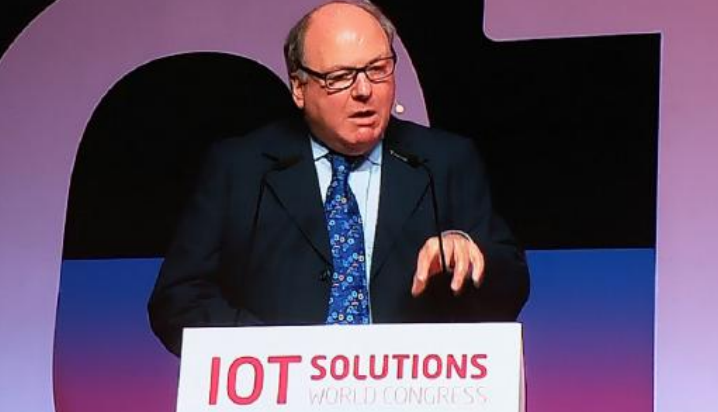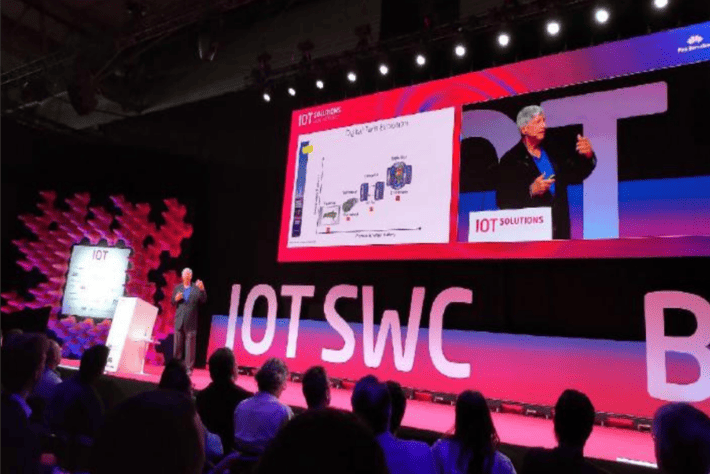The annual IoT Solutions World Congress in Barcelona recently took place, and Antony Savvas was there for IoT Now to find out how industry movers and shakers were tackling challenges around connectivity, building partner ecosystems, sustainability and evolving standards.
With more than 300 exhibitors and over 250 speakers, the IoT Solutions World Congress, organised by Fira de Barcelona and the Industry IoT Consortium, featured firms such as ABB, Amazon Web Services, Device Authority, Entrust, Emnify, Faircom, KNX, STMicroelectronics, Nozomi Networks, Relayr, Sternum, Deutsche Telekom and TxOne, among others.
The IoT market is expected to grow 18% in 2023, reaching more than 14.4 billion active connections, according to IoT Analytics. It also estimates there will be more than 27 billion connected devices by 2025. With this sort of growth there are expected to be issues around deployments and connectivity capacity, let alone factoring in the changing market conditions as a result of rising energy prices and a tense geopolitical situation.
Deployments
At the show, IoT connectivity services firm Eseye demonstrated how it is making it easier for partners and enterprises to deploy solutions. It showcased its AnyNet SMARTconnect on-device connectivity software platform. The offering embeds intelligent, global IoT connectivity directly into any device, aiming to enable organisations to get to market faster and to focus on creating value for their customers.
Smart building specialist the KNX Association was also active on the deployment and connectivity front at the show. It launched a new solution to connect all major smart home devices, including those from the likes of Apple, Google, Amazon and Philips.
The KNX standard is one backed and used by 500 manufacturers globally, all involved in the provision of smart building technology. The standard is said to be currently integrated into 8,000 different products.
KNX Association CEO, Heinz Lux said at the launch: “Semantic connectivity for all IoT products in the world is coming.” Semantic technologies revolve around a set of methods and tools for machines that provide advanced means for categorising and processing data. “For our industry, we are offering a combination of IPV6, KNX IoT project deployment experience and semantic software to offer our KNX IoTech solution,” said Lux.
As a result, he says, the smart home products from Apple, Google, Amazon and Philips, among others, can all be connected for the first time without any “complicated” router or gateway appliances. “KNX does not want to replace any of these brands, we just want them to communicate with each other, using our tools and our software sitting on top of them,” added Lux. Up to now, he says, many existing smart home appliances have “basically been proprietary”, through not working with rival solutions.
The move was welcomed by Qt Group, a software company used by developers to create applications and smart devices through the entire product development lifecycle, from user interface (UI) design and software development to quality management and deployment. Patrick Dalez, business line director at Qt, told IoT Now: “The move by KNX is a logical one in the smart building sector and it is something that should be happening in other sectors like health, electric vehicles, smart cities and other verticals.”
Government
Speaking of government, a number have made recent announcements around security and standardisation. The US government plans standardised security labelling for consumer IoT devices, and the UK is planning its own product security and telecoms infrastructure protection legislation. The European Commission is also seeking to further legislate over how data can be collected and stored, and how organisations can mitigate data breaches.
The European Commission gave the first keynote at the Barcelona event, in connection with how industry could improve its productivity using IoT technology, while at the same time protecting workers in the process. Sean O’Reagain, deputy head of Industry 5.0 at the Commission, demanded a replacement for Industry 4.0 with a “more human touch”. He said the Commission wanted to “future-proof” industry while at the same time making sure it helped support the Commission’s green deal industry plan and its net zero targets.
“Industry 4.0 was all about capitalising on productivity improvements, but Industry 5.0 must be human centric, resilient and support sustainability efforts,” said O’Reagain. “Workers must be at the centre of Industry 5.0 development, which must take account of their welfare. They must be seen as an investment, not a cost.”
On the legislative side, O’Reagain confirmed the Commission would consider taxation and employment law to encourage industry to adopt a more ethical Industry 5.0. IoT data collected through projects and industry partnerships, says O’Reagain, will support the Commission’s strategy.

Digital twins
One way for industry to adopt Industry 5.0 is the use of digital twins. The idea is that a virtual twin of an existing product or service is generated, using constantly collected manufacturing and business data, to make sure the product is maintained and improved. Alternatively, if an organisation is developing and building a new product, it may well build a digital twin using ongoing development and business data to check that the product will work, before launching the physical product (the other twin) to market.
However, the IoT connectivity needed to support such strategies is facing a big test, as more companies adopt digital twins and more data is generated around them, the Congress heard. Michael Grieves, chief scientist and executive director of the Digital Twin Consortium, has held senior roles at the likes of Boeing, GM and NASA over the last 50 years, and he was worried.
“By 2030, the computer systems used by industry will be 128 times more powerful than today when it comes to data generation, and, by 2040, they will be 16,000 times more powerful,” said Grieves. He is concerned that existing IoT sensors, appliances and networks will not be able to handle such data workloads when it comes to feeding digital twins.
Whatever the concerns about the adoption of Industry 5.0 and digital twins, Anand Gandhi, senior vice president of global enterprise sales at Eseye, warns that the industry first has to make sure what is promised already is fully delivered and supported. “There are exhibitors at this show who are simply selling IoT SIMs, that’s not a solution, it’s a product,” he said. “For something to be worthwhile and to take the market forward, it has to be an end-to-end connectivity solution that has a roadmap to it. You cannot future-proof connectivity without an ecosystem of many different network providers in multiple geographies actively supporting it.”
Sustainable edge data
Global engineering group ABB says it is using IoT to try and reduce the world’s energy consumption by 10%. Mari Haapala, digital lead of the ABB Motion unit, told the conference that expert analysis of data from digitally connected motors and drives can identify the best ones to boost energy efficiency.
“45% of all energy in the world is used by motors, making this process more efficient can have a huge positive effect towards achieving net zero,” she said. “If we achieve this we (the IoT industry. Ed.) could save 10% of the world’s energy.”
Haapala says 75% of the world’s motors are not run efficiently, and ABB wants to provide IoT data to the industry to help optimise them, re-purpose them or, where necessary, replace them. ABB is working with companies like Microsoft to help improve sustainability in industry through ABB’s Energy Efficiency Movement, which has also seen the likes of Deutsche Post, DHL Group and Alfa Laval join it.
Comment on this article below or via Twitter: @IoTNow_










